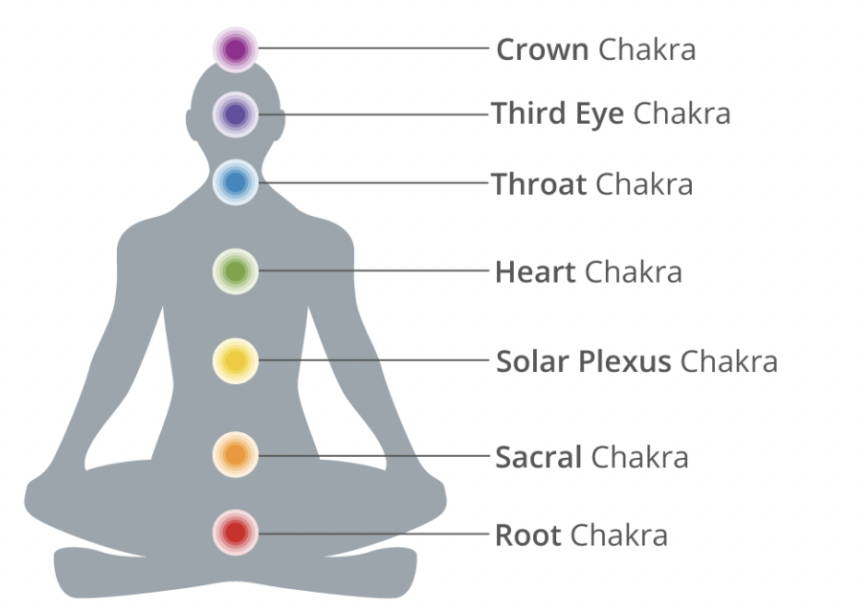Your Complete Guide to the 7 Chakras

The word "chakra" is derived from Sanskrit and means "wheel" or "vortex". The seven chakras are considered to be spinning wheels of energy that correspond to specific areas of the body. They are said to regulate the flow of energy and connect the physical body to the spiritual realm. According to one article, "The chakra system originated in India between 1,500 and 500 B.C. in the oldest text called the Vedas," says Fern Olivia, a reiki healer and yoga instructor.
If you're looking for a way to balance your mind, body, and spirit, the seven chakras may be just what you need. These energy centers are located along the spine and correspond to different aspects of our physical and emotional well-being. By understanding and working with the chakras, you can create a harmonious flow of energy throughout your body and lead a more fulfilling life.
Here are the seven chakras, starting from the base of the spine and moving upward:
- Muladhara (Root Chakra) - located at the base of the spine, this chakra is associated with stability, security, and grounding.
- Svadhisthana (Sacral Chakra) - located just above the pubic bone, this chakra is associated with creativity, sexuality, and emotions.
- Manipura (Solar Plexus Chakra) - located in the upper abdomen, this chakra is associated with self-esteem, personal power, and confidence.
- Anahata (Heart Chakra) - located in the center of the chest, this chakra is associated with love, compassion, and relationships.
- Vishuddha (Throat Chakra) - located in the throat, this chakra is associated with communication, self-expression, and truth.
- Ajna (Third Eye Chakra) - located between the eyebrows, this chakra is associated with intuition, wisdom, and perception.
- Sahasrara (Crown Chakra) - located at the top of the head, this chakra is associated with spiritual connection, awareness, and enlightenment.
Why are the Chakras Important?
The Science Behind Chakras
There is a scientific explanation for why some people associate the concept of chakras with specific areas of the body. The human body has complex systems of nerves, and there are indeed bundles of nerves located where the chakras are traditionally said to be located.
For example, the first chakra, the root chakra, is said to be located at the base of the spine. This area corresponds to the sacral plexus, which is a bundle of nerves that controls many of our involuntary functions, such as the muscles of the pelvis, legs, and feet. Similarly, the second chakra, the sacral chakra, is said to be located near the pubic bone and is associated with the reproductive and urinary systems, which are controlled by the lumbar plexus, another bundle of nerves. This correlation between the chakras and the physical nerve centers of the body provides a scientific basis for the association between the two.

How to Balance Your Chakras: The Basics
One article points out that disease is often times caused from an imbalance in the chakras..."It is usually only when this dis-ease manifests as pain or a physical ailment that we’re directed to give it attention. A plethora of modern pharmaceutical or surgical fixes, may alleviate physical aspects of a problem, but the underlying cause, which lies in the energetic framework, remains unresolved" (Divine Bliss International)
Balancing your chakras is a lifelong journey, but there are many simple and effective ways to get started. Here are some tips to help you get started:
1. Pay attention to your physical and emotional experiences - When one or more chakras are blocked, you may experience physical or emotional symptoms. For example, if your root chakra is blocked, you may feel anxious or ungrounded. If your heart chakra is blocked, you may struggle with relationships or feelings of loneliness. By paying attention to your experiences, you can identify which chakras need the most attention.
2. Practice yoga and meditation - Yoga and meditation are excellent ways to balance the chakras. Certain yoga poses and meditations can be used to focus energy on specific chakras and help unblock stagnant energy.
3. Use essential oils and crystals - Certain essential oils and crystals correspond to specific chakras and can be used to help balance and align your energy. For example, you can use sandalwood oil and clear quartz to balance your crown chakra, or orange oil
Symptoms of Blocked Chakras
Root: A blocked root chakra, also known as the Muladhara chakra, can result in physical, emotional, and mental imbalances. This chakra is located at the base of the spine and is associated with a sense of security, stability, and grounding. When the root chakra is blocked, it can result in the following symptoms
- Physical symptoms such as fatigue, weakness, and instability in the legs and feet
- Emotional symptoms such as anxiety, fear, and feelings of insecurity
- Mental symptoms such as confusion, memory loss, and difficulty focusing
- Financial and material difficulties, or an excessive preoccupation with money or material possessions
- Physical discomfort in the lower back, legs, and feet
- Chronic stress or fatigue, with a feeling of always being on edge
- Difficulty connecting with others or feeling disconnected from the world around you
Sacral: The sacral chakra, or Svadhisthana, is associated with creativity, sexuality, and emotions. When this chakra is blocked, it can lead to a number of negative effects on both the physical and emotional levels. Some common symptoms of a blocked sacral chakra include:
- Low libido or sexual dysfunction
- Creativity blocks and lack of motivation
- Difficulty expressing emotions and feeling disconnected from others
- Physical discomfort in the lower back, hips, or reproductive area
- Bladder or kidney problems
- Eating disorders or an unhealthy relationship with food
Solar: A blocked solar plexus chakra, also known as the Manipura chakra, can result in physical, emotional, and mental imbalances. This chakra is located in the upper abdominal region and is associated with personal power, self-esteem, and confidence. When the solar plexus chakra is blocked, it can result in the following symptoms:
- Physical symptoms such as digestive problems, abdominal pain, and digestive disorders
- Emotional symptoms such as low self-esteem, feelings of inadequacy, and difficulty expressing oneself
- Mental symptoms such as indecisiveness, lack of confidence, and difficulty setting boundaries
- Difficulty standing up for oneself or asserting oneself in relationships and social situations
- Chronic stress or anxiety, with a tendency to take on the stress of others
- Difficulty accepting compliments or positive feedback
- Low energy levels, feeling mentally or physically "stuck"
Heart: A blocked heart chakra, also known as the Anahata chakra, can result in physical, emotional, and mental imbalances. This chakra is located in the center of the chest and is associated with love, compassion, and emotional balance. When the heart chakra is blocked, it can result in the following symptoms:
- Physical symptoms such as chest pain, high blood pressure, and respiratory difficulties
- Emotional symptoms such as feelings of loneliness, sadness, and a lack of connection with others
- Mental symptoms such as jealousy, bitterness, and a tendency to hold grudges
- Difficulty expressing love and affection towards oneself and others
- Chronic feelings of anger, resentment, or bitterness
- Difficulty forgiving others or oneself
- A tendency to withdraw emotionally from others or to emotionally "armour" oneself
Throat: A blocked throat chakra, also known as the Vishuddha chakra, can result in physical, emotional, and mental imbalances. This chakra is located in the throat region and is associated with communication, self-expression, and creativity. When the throat chakra is blocked, it can result in the following symptoms:
- Physical symptoms such as throat pain, neck pain, and thyroid problems
- Emotional symptoms such as difficulty expressing oneself, shyness, and a tendency to avoid speaking up or asserting oneself
- Mental symptoms such as indecisiveness, confusion, and difficulty making decisions
- Difficulty expressing oneself creatively, artistically, or verbally
- Chronic feelings of being unheard, misunderstood, or dismissed
- Avoidance of conflict or tendency to suppress one's own feelings and opinions
- Difficulty setting boundaries and asserting oneself in relationships and social situations
Third-Eye Chakra: A blocked third eye chakra, also known as the Ajna chakra, can result in physical, emotional, and mental imbalances. This chakra is located between the eyebrows and is associated with intuition, perception, and wisdom. When the third eye chakra is blocked, it can result in the following symptoms:
- Physical symptoms such as headaches, eye strain, and sinus problems
- Emotional symptoms such as confusion, fear, and a tendency to overanalyze or overthink
- Mental symptoms such as a lack of intuition or a sense of disconnection from one's inner wisdom
- Difficulty trusting one's intuition or inner voice
- Chronic feelings of being "stuck" or directionless in life
- A tendency to overthink or second-guess oneself
- A tendency to become overly attached to logic, reason, and intellect at the expense of intuition and spiritual insight
Crown Chakra: A blocked crown chakra, also known as the Sahasrara chakra, can result in physical, emotional, and mental imbalances. This chakra is located at the crown of the head and is associated with spiritual connection, enlightenment, and universal consciousness. When the crown chakra is blocked, it can result in the following symptoms:
- Physical symptoms such as headaches, depression, and chronic fatigue
- Emotional symptoms such as feelings of disconnection from spirituality, a lack of purpose or meaning, and feelings of hopelessness or despair
- Mental symptoms such as confusion, a sense of being "stuck" or directionless, and a lack of inspiration or motivation
- Difficulty connecting with a higher power or a sense of transcendence
- Chronic feelings of being disconnected from the divine or from one's own inner wisdom
- A sense of cynicism or skepticism about spiritual matters
- Difficulty accessing higher levels of consciousness or experiencing a sense of transcendence or spiritual connection
Symptoms of Overactive Chakras
Root: When the root chakra is overactive, it can result in the following symptoms:
- Physical symptoms such as feelings of restlessness, anxiety, and chronic stress
- Emotional symptoms such as fear, anger, and aggression
- Mental symptoms such as obsessiveness, paranoia, and a constant need for control
- A tendency to be excessively attached to material possessions, money, or physical security
- Chronic feelings of insecurity, instability, or a sense of disconnection from the physical world
- A tendency to become overly focused on survival and security at the expense of personal growth and development
- Difficulty letting go of old patterns and habits that no longer serve you
Sacral: When the sacral chakra is overactive, it can result in the following symptoms:
- Emotional symptoms such as excessive emotionalism, mood swings, and difficulty controlling one's emotions
- Physical symptoms such as sexual dysfunction, digestive problems, and chronic fatigue
- Mental symptoms such as addiction, compulsive behaviors, and a constant need for stimulation
- A tendency to become overly attached to pleasure, sensual experiences, or material comfort
- Chronic feelings of emotional instability or instability in relationships
- Difficulty setting healthy boundaries in relationships and with oneself
- A tendency to become addicted to pleasure, material comfort, or excess
Solar: When the solar plexus chakra is overactive, it can result in the following symptoms:
- Physical symptoms such as digestive problems, anxiety, and chronic stress
- Emotional symptoms such as feelings of anger, frustration, and a tendency to become easily irritated or frustrated
- Mental symptoms such as a constant need for control, a perfectionist streak, and a tendency to become overly competitive or aggressive
- A tendency to become overly attached to personal power, control, or status
- Chronic feelings of low self-esteem, insecurity, or a lack of confidence
- A tendency to become overly assertive or aggressive in personal and professional relationships
- Difficulty accepting feedback or criticism, and a tendency to become defensive when challenged
Heart: When the heart chakra is overactive, it can result in the following symptoms:
- Physical symptoms such as chronic chest or heart problems, such as palpitations or heart disease
- Emotional symptoms such as a tendency to become overly attached to others, or to become codependent in relationships
- Mental symptoms such as a constant need to please others, and a difficulty in setting healthy boundaries
- A tendency to become overly sentimental, or to become easily hurt or offended
- Chronic feelings of loneliness, sadness, or isolation, despite being surrounded by many people
- A tendency to become overly involved in the problems of others, at the expense of one's own wellbeing
- Difficulty in establishing healthy and fulfilling relationships, due to a fear of rejection or abandonment
Throat: When the throat chakra is overactive, it can result in the following symptoms:
- Physical symptoms such as chronic throat problems, such as sore throats or laryngitis, and thyroid imbalances
- Emotional symptoms such as a tendency to become argumentative or overly critical in personal relationships
- Mental symptoms such as a constant need to express oneself, a tendency to become overly talkative, and difficulty listening to others
- A tendency to become overly attached to personal opinions and ideas, and a difficulty in accepting differing viewpoints or perspectives
- Chronic feelings of frustration or anger when personal truths are not acknowledged or respected
- A tendency to become judgmental or critical of others, and a difficulty in establishing healthy relationships
- Difficulty in finding the right words to express oneself, or a tendency to become overly verbose
Third-Eye: When the third eye chakra is overactive, it can result in the following symptoms:
- Physical symptoms such as headaches, migraines, and vision problems
- Emotional symptoms such as a tendency to become overly introspective, or to become detached from others
- Mental symptoms such as a constant need for intellectual stimulation, and a difficulty in relaxing or slowing down
- A tendency to become overly analytical, and to become fixated on details and minutiae
- Chronic feelings of anxiety, confusion, or disorientation, even in familiar surroundings
- A tendency to become skeptical, or to dismiss the perspectives of others
- Difficulty in establishing healthy relationships, due to a tendency to become overly critical or dismissive of others
Crown Chakra: When the crown chakra is overactive, it can result in the following symptoms:
- Physical symptoms such as headaches, dizziness, or a sensitivity to light and sound
- Emotional symptoms such as a tendency to become overly detached from the physical world, or to become disinterested in material pursuits
- Mental symptoms such as a constant need for spiritual enlightenment, and a difficulty in finding meaning or purpose in mundane tasks
- A tendency to become overly focused on spiritual pursuits, at the expense of one's relationships, health, or well-being
- Chronic feelings of confusion, disorientation, or disconnection, even in familiar surroundings
- A tendency to dismiss the perspectives of others, and to become self-absorbed or self-obsessed
- Difficulty in establishing healthy relationships, due to a lack of empathy or connection to others
Eating for Your Chakras

Eating for your chakras means incorporating foods and eating habits that support the energy centers in your body. Here are some tips for eating for each of the seven chakras:
1. Root Chakra (Muladhara) - This chakra is associated with the earth element, and is located at the base of the spine. To support this chakra, it's recommended to eat grounding foods like root vegetables (such as potatoes, carrots, and beets), nuts and seeds, and red fruits like strawberries and cherries. Eating slowly and mindfully can also support the root chakra.
2. Sacral Chakra (Svadhisthana) - This chakra is associated with the water element, and is located in the lower abdomen. To support this chakra, it's recommended to eat foods that are juicy, hydrating, and nourishing, such as oranges, grapes, and melons. You can also eat foods that support healthy sexual energy, such as figs, avocados, and functional mushrooms.
3. Solar Plexus Chakra (Manipura) - This chakra is associated with the fire element, and is located in the upper abdomen. To support this chakra, it's recommended to eat foods that are warming and energizing, such as ginger, chili peppers, and yellow fruits like lemons and pineapples. Eating slowly and mindfully can also help to balance the solar plexus chakra.
4. Heart Chakra (Anahata) - This chakra is associated with the air element, and is located in the center of the chest. To support this chakra, it's recommended to eat foods that are green and leafy, such as spinach, kale, and lettuce. Eating foods that are high in antioxidants, such as berries, can also help to support the heart chakra.
5. Throat Chakra (Vishuddha) - This chakra is associated with the ether element, and is located in the throat. To support this chakra, it's recommended to eat foods that are cooling and soothing, such as mint, cucumber, and coconut water. Eating foods that are high in calcium, such as dairy products or leafy greens, can also help to support the throat chakra.
6. Third Eye Chakra (Ajna) - This chakra is associated with the light element, and is located between the eyebrows. To support this chakra, it's recommended to eat foods that are purifying and cleansing, such as purple foods like grapes, blueberries, and blackberries. Eating foods that are high in antioxidants, such as leafy greens, can also help to support the third eye chakra.
7. Crown Chakra (Sahasrara) - This chakra is associated with the consciousness element, and is located at the top of the head. To support this chakra, it's recommended to eat foods that are light and nourishing, such as fruit, nuts, and seeds. Eating foods that are high in antioxidants, such as berries, can also help to support the crown chakra.
Remember that eating for your chakras is not a strict dietary regimen, but rather a way to incorporate mindfulness and intention into your eating habits. By eating foods that support each of your chakras, you can create a balanced and harmonious diet that promotes overall health and well-being.
How to Cleanse and Purify each Chakra

Cleansing your chakras is a process of removing blockages and restoring the flow of energy through each of the seven energy centers in your body. Here are some ways to cleanse each of the chakras:
1. Root Chakra (Muladhara) - This chakra is associated with the earth element, and is located at the base of the spine. To cleanse this chakra, you can try grounding practices like walking barefoot on the earth, doing yoga, or meditating. You can also use essential oils like sandalwood, patchouli, or vetiver to help balance the root chakra.
2. Sacral Chakra (Svadhisthana) - This chakra is associated with the water element, and is located in the lower abdomen. To cleanse this chakra, you can try water therapies like taking a bath, going for a swim, or spending time in nature near a body of water. You can also use essential oils like ylang-ylang, jasmine, or orange to help balance the sacral chakra.
3. Solar Plexus Chakra (Manipura) - This chakra is associated with the fire element, and is located in the upper abdomen. To cleanse this chakra, you can try heat therapies like taking a warm bath, doing yoga, or spending time in nature in the sun. You can also use essential oils like ginger, cinnamon, or peppermint to help balance the solar plexus chakra.
4. Heart Chakra (Anahata) - This chakra is associated with the air element, and is located in the center of the chest. To cleanse this chakra, you can try practices that help you connect with your emotions, such as writing in a journal, meditating, or spending time in nature. You can also use essential oils like rose, lavender, or chamomile to help balance the heart chakra.
5. Throat Chakra (Vishuddha) - This chakra is associated with the ether element, and is located in the throat. To cleanse this chakra, you can try practices that help you express your truth, such as singing, speaking, or writing. You can also use essential oils like peppermint, eucalyptus, or lemon to help balance the throat chakra.
6. Third Eye Chakra (Ajna) - This chakra is associated with the light element, and is located between the eyebrows. To cleanse this chakra, you can try practices that help you connect with your intuition, such as meditating, practicing mindfulness, or spending time in nature. You can also use essential oils like frankincense, myrrh, or sandalwood to help balance the third eye chakra.
7. Crown Chakra (Sahasrara) - This chakra is associated with the consciousness element, and is located at the top of the head. To cleanse this chakra, you can try practices that help you connect with your spirituality, such as meditation, mindfulness, or spending time in nature. You can also use essential oils like lavender, frankincense, or sandalwood to help balance the crown chakra.
Working with your chakras is a great way to achieve a sense of balance in your life. By removing blockages, and allowing the flow of energy to run smoothly throughout your body, you should expect to feel more at ease in your daily life. We hope we have given you all the necessary information to embark on your inner-journey and self-discovery with the seven chakras.
Sources:
Divine Bliss International. "Chakras: The Complete Guide to Understanding and Balancing Your Body’s Energy Centers." Divine Bliss International, n.d. Web. Accessed on March 27, 2023. https://divineblissinternational.org/chakras-2/?gclid=CjwKCAjw_YShBhAiEiwAMomsECb8I18xAuKzgsnuW5uRWbPFPkW8nJath3vyaQ7mIRdb81gsBwPRkxoCOKMQAvD_BwE
